Have you ever fancied having a micro-living system in a transparent box that lodges small plants and animals? That’s been quite similar to the terrarium idea.
Putting up a terrarium may seem easy, but there are many tricky things to consider. So, let’s not miss out on the essentials and learn how to build multiple terrariums!
Table of Contents Show
What is a Terrarium? Things You Should Learn
A terrarium refers to an artificially crafted micro-habitat to foster particular plants and animals inside a burnished, confined space for study or to impose an indoor vista.
It is a miniature indoor garden or small ecosystem nursing specific petite plants and animals inside a closed or open glass dome.
To be precise, there are many versions of terrariums, and they come in different shapes and sizes.
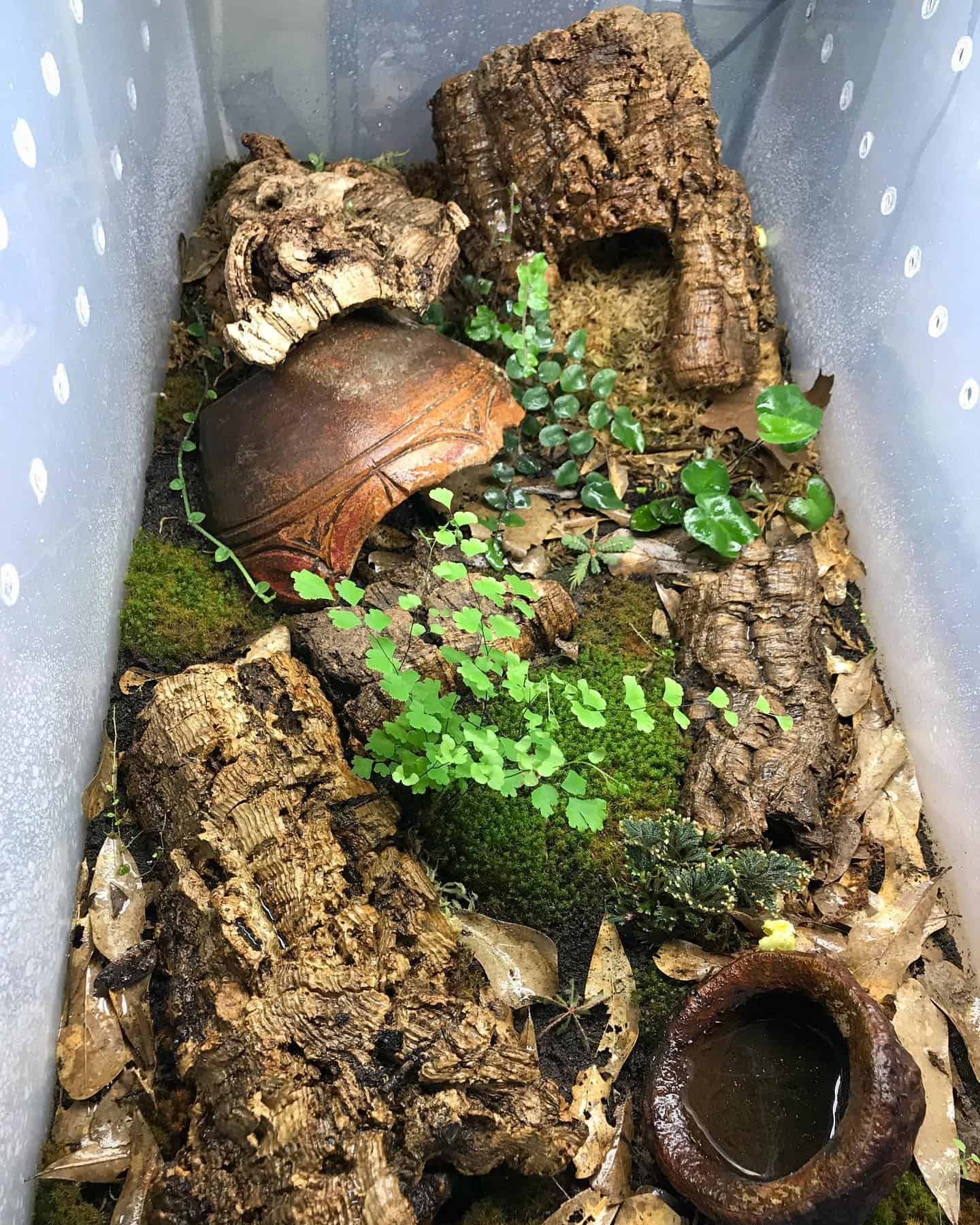
But, while building a terrarium, we shouldn’t forget about its purpose in the first place.
- Terrariums are perfect for plants that can survive in a small space and humid air.
- Watering schedules are reduced as the moisture cycling inside terrariums works independently.
- They offer an aesthetic indoor look and can be placed in any room once they become self-sustaining.
- Plants can get more carbon and animals more oxygen due to rapid carbon and oxygen cycling.
- They are great DIY projects for nature enthusiasts who want to study the relationship between plants and animals more closely.
Types of Terrariums
There are two terrarium types, open and closed, with different working mechanisms.
An open terrarium is opened from a side, mostly on top, while a closed terrarium is sealed from all sides.
It makes the perfect home for large humidity-loving amphibians, reptiles, insects, and plants.
While closed terrariums befit small moisture-loving plants and insects.
Furthermore, both terrariums incorporate hardscape elements (soil, rocks, pebbles, water source, wood or logs, and carbon) depending on your building type.
Hence, some terrariums can have more similar hardscape elements than others.
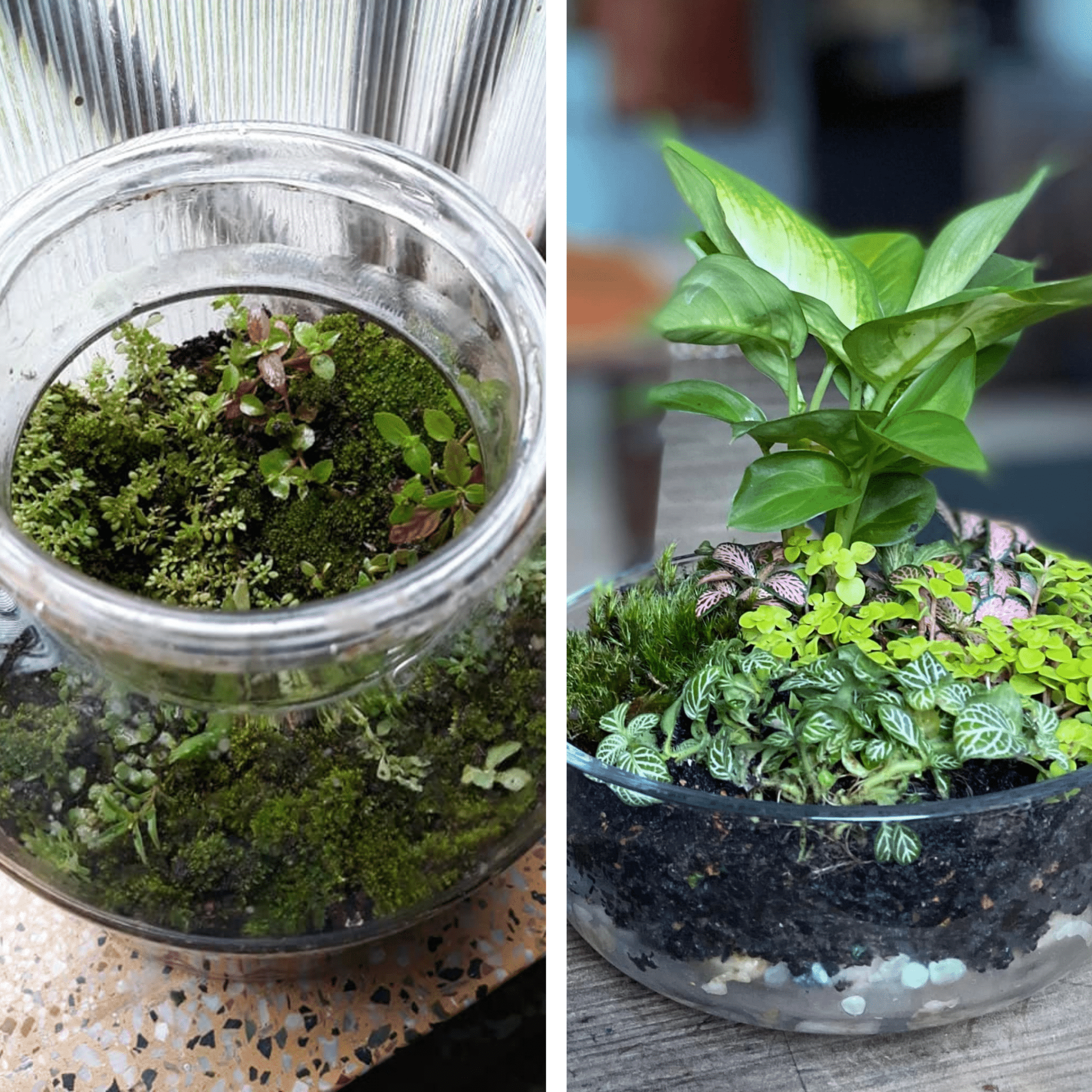
A glass dome is the main element holding the plants and animals in a terrarium. It can be as small as a resealable glass jar or a large open-top glass tank.
Terrarium Layers
Since a terrarium is a closed or open semi-natural ecosystem, you must imitate a similarly feasible environment for the plants and animals.
A basic terrarium has 4 major layers, each with different elements and functions.
However, many animal terrariums may not have all the layers, which is basically due to the diverse habit of animals.
Drainage Layer: Elements of this layer consist of small pebbles and charcoal placed at the bottom to offer drainage.
Substrate Layer: It contains a thick soil layer to offer a proper ground for the plant’s growth.
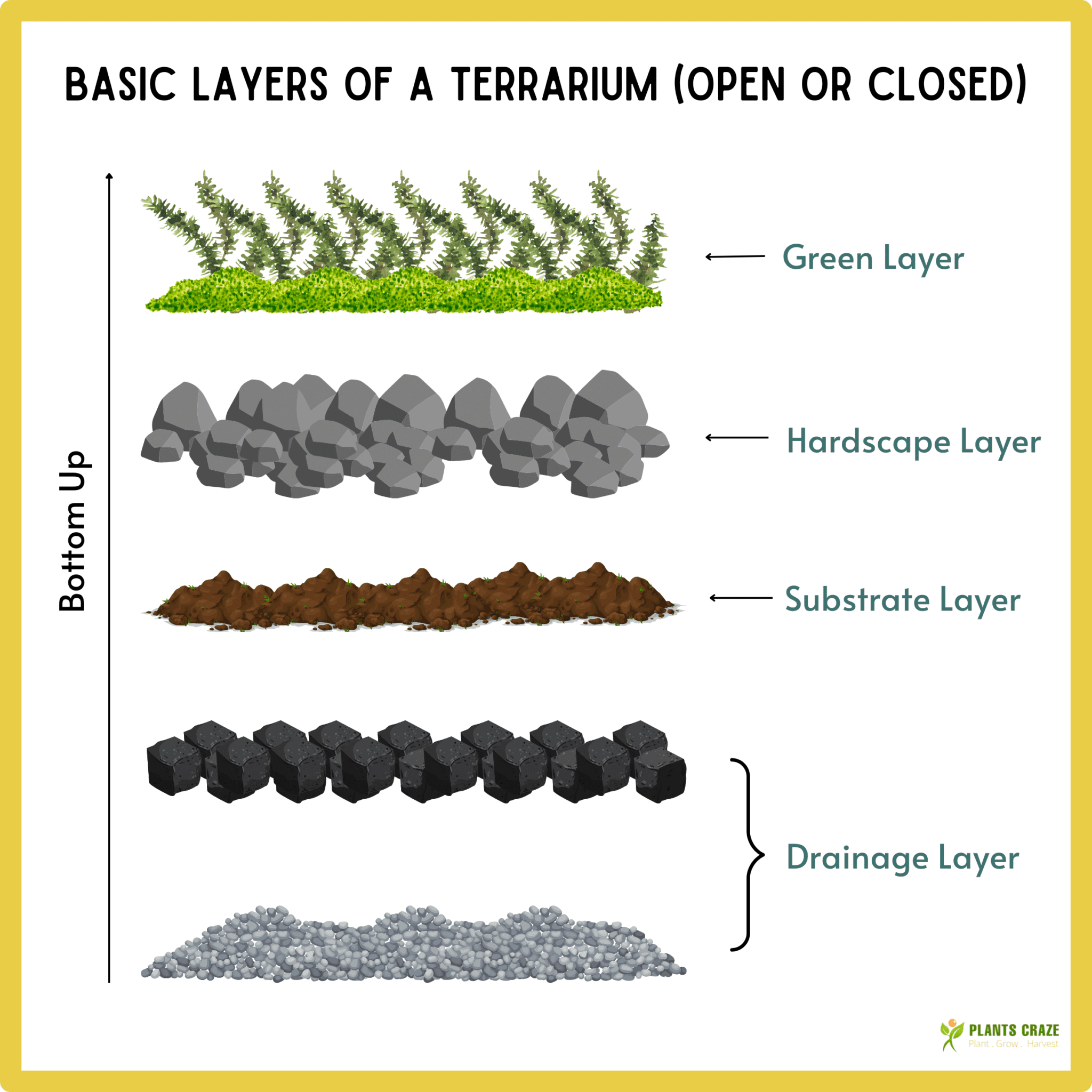
Hardscape Layer: A decorative layer consists of large rocks and small or large twigs imitating a natural environment organized by the framer.
Green Layer: The bioactive layer boasts green plants and animals responsible for the carbon and oxygen cycling inside the terrarium.
Conditions for Terrariums
Not all plants and animals share similar growth needs, which may change the design of terrariums.
However, the following conditions must be met for plants and animals to survive inside terrariums.
- Keep optimum humidity around 60-90%.
- Maintain a temperature between 55°F and 85°F. Avoid letting the temperature go below 50°F at night.
Reptile terrariums may require a temperature ranging between 75°F and 120°F.
- Locate terrariums near an east-facing window with bright indirect sunshine for 4-6 hours daily.
- Prefer a percolating soil with a pH between 4 and 7.
3 Main DIY Terrarium Ideas
Here are a few terrarium ideas you can salvage with all the care tips to sustain them.
1. Terrarium Ideas with Animals
An animal terrarium mostly comprises miniature critters such as insects, reptiles, and amphibians with plants and hardscape components.
These animals like hot, humid, and moist places.
Besides, large animals like reptiles and amphibians require more irregular hardscape elements with humidity and a constant oxygen supply. So, an open terrarium works best for them.
Contrarily, smaller animals like insects can thrive in a closed terrarium with other plants.
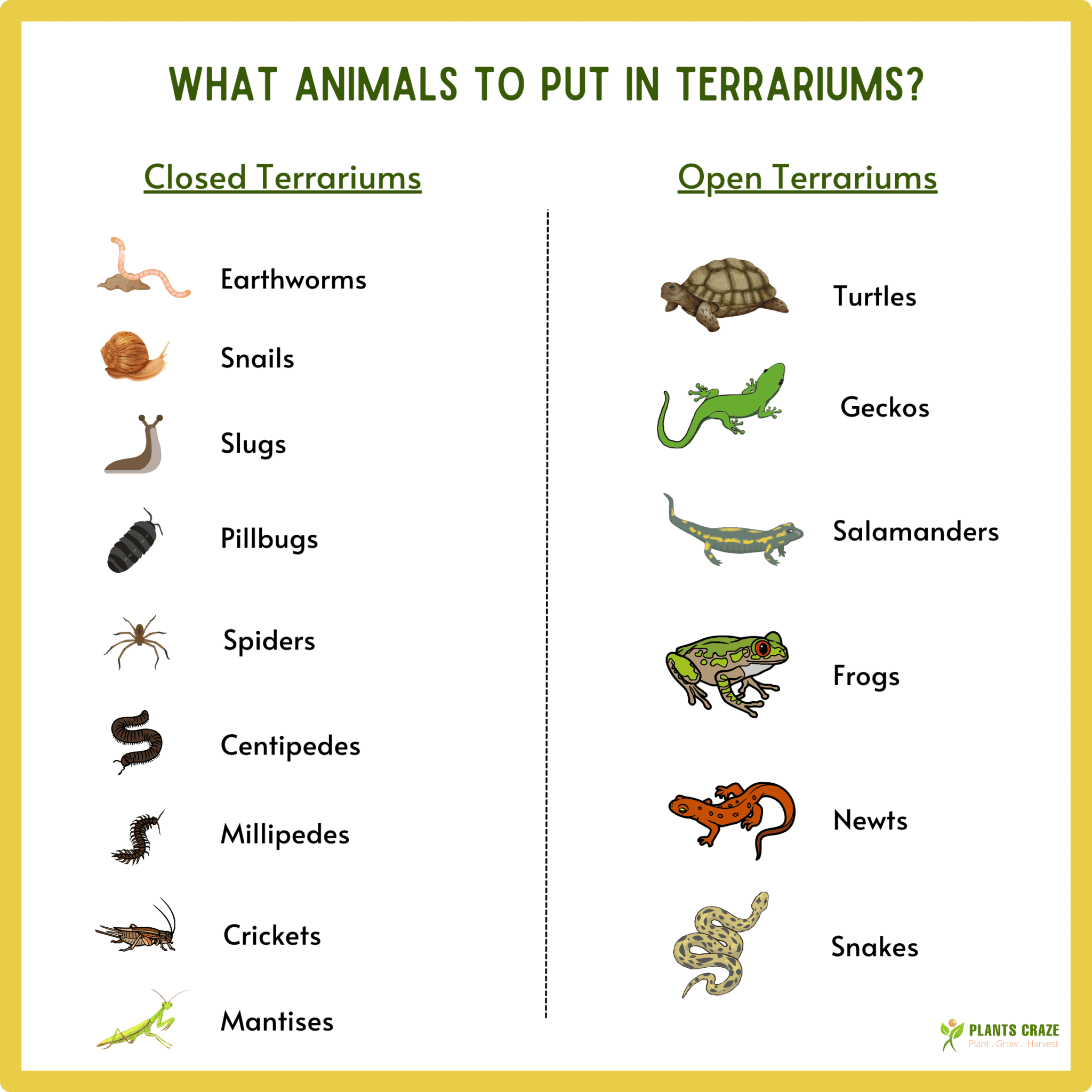
Amphibian Terrarium Ideas
Amphibians, like frogs, toads, newts, salamanders, and small insects (pillbugs, millipedes, spiders, centipedes, and springtails), are the top choices for open terrariums.
Additionally, amphibians are tropical animals and can suit themselves in warm, humid terrarium environments.

Normally, these amphibian terrariums combine terrarium and aquarium features due to more water components.
Technically, these kinds of semi-terrariums are called paludariums.
- Select a large Paludarium tank with an automatic left/right or top/down LED lighting facility.
- Clean it thoroughly with a 10% bleach solution to remove any contaminants.
- Place small aquarium pebbles mixed with horticultural charcoal as the bottom substrate to the desired thickness.
- Then, add fallen tree logs and large boulders that can fit inside the terrarium while also being spacious for the animals.
- You can also create a small pond to offer tropical vibes for the amphibians.
- Place tropical plants such as mosses, aroids, and ferns in your terrarium.
- Add the frogs, newts, and salamanders to the enclosure after 1-2 weeks.
- Keep the setup near bright indirect sunlight for 4-6 hours daily and avoid the scorching sun.
- You can monitor the temperature and humidity using a thermometer-humidity checker. Use LED lights at night.
- Clean the terrarium monthly using dilute bleach and hot water.
- Feed the animals fruit flies or pin-head crickets weekly for 15-20 minutes.
To provide additional drainage, you can add LECA balls to the topsoil.
You can watch the full video for a guide to building your own Amphibian terrarium.
Reptile Terrarium Ideas
Reptiles like snakes, leopard geckos, bearded dragon lizards, and tortoises can also work well with many tropical plants and hardscape components in a terrarium.
However, reptile terrariums must have an opening vent and be rockier with less greenery.
Also, it’s ideal for your own safety not to use venomous reptiles inside the inclusion.
Here is the step-by-step guide for preparing a Reptile terrarium.
- Prepare a large reptile tank with a top or side opening and clean it with a 10% bleach solution.
- Add pebbles as the bottom substrate and arrange large boulders and logs to create caverns for the reptiles to hide.
- Incorporate green elements, like plants, that are suitable for dry habitats but also can resist a bit of humidity.
- Place a heating mat below one side of the tank so the animal can regulate its body temperature.
- Keep a watering tray on one side of the tank, or create a miniature pond using rocks and logs.
- Use automatic UVA and UVB lights and maintain a 12-hour day and night cycle.
- Observe temperature and humidity changes using a thermometer-humidity checker.
- Clean the tank monthly using hot water and dilute bleach solution.
- Feed your animals regularly or every 1-2 weeks, depending on the species.
You can also add insects to the Amphibian and Reptile terrariums, which can be their daily meals, but they are more suited for the Plant terrariums!
2. Terrarium Ideas with Air Plants
Most Tillandsia species are called Air Plants and belong to the Bromeliaceae family.
These plants are epiphytes that attach themselves to the host trees and absorb moisture and nutrients from the leaves instead of roots.
So, these are perfect plants for placing in Open terrariums with minimal substrate support.
Let’s look at the steps for building an Air Plant terrarium.
- Take a round glass jar, with a top or side opening, for small air plants and big glass jars for larger plants.
- For small plants, you can grow up to 3 in a jar, while for larger plants, place one per jar.
- Place a 2-inch layer of sand and another aquarium pebbles layer at the base of the bowl.
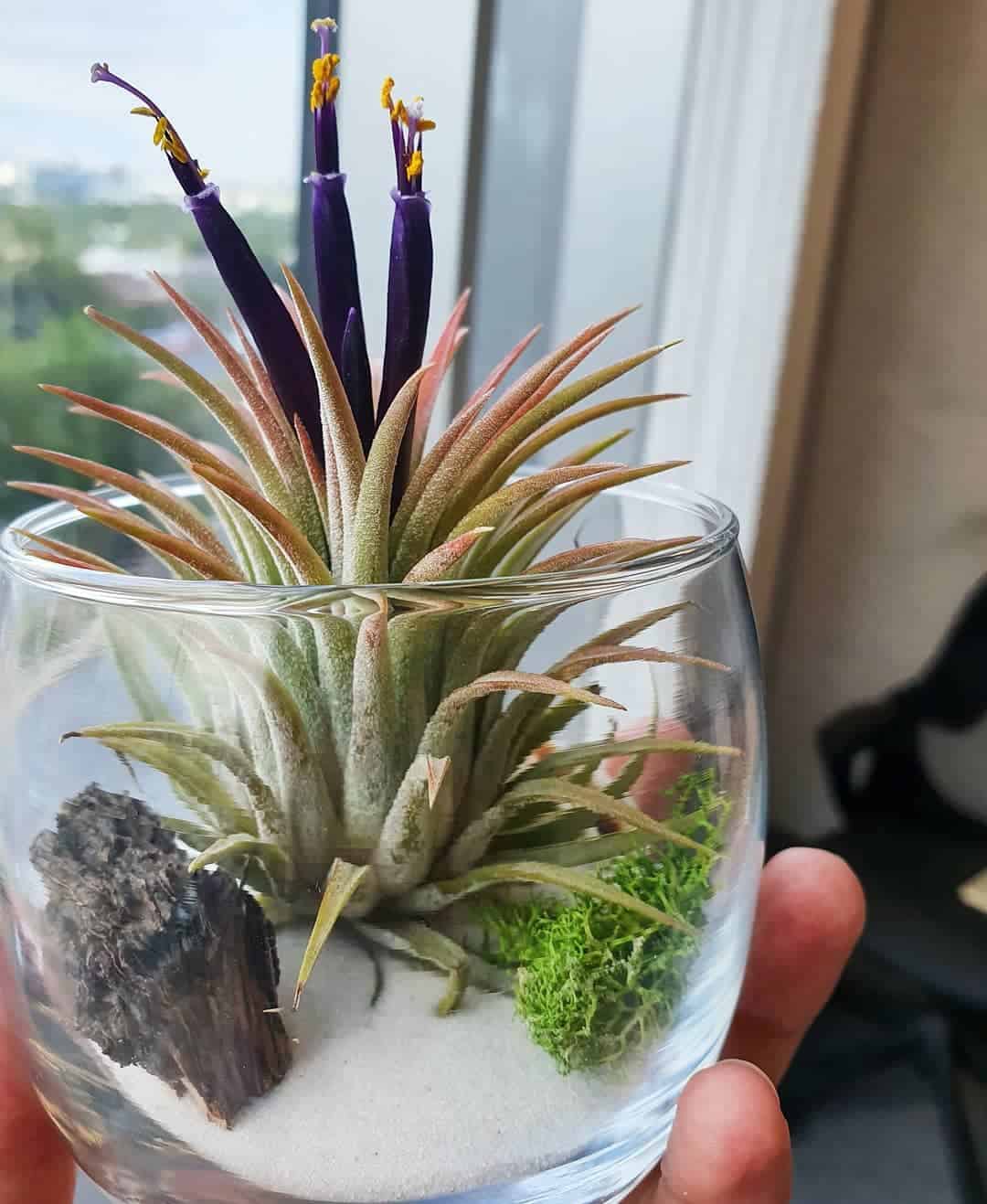
- Now you can decorate it with colorful stones or sand or use seashells.
- Place dead logs and then moss over them for moisture and decor.
- Place the terrarium near an east-facing window for 4-6 hours daily.
- Take the set-up out once a week to soak in water for 1/2-2 hours and dry them for 4 hours at room temperature.
- Pull any growing buds off the plant using sterilized tweezers and repeat the process.
You should keep the terrariums away from cold, drafty windows. Tillandsias hate cold and may succumb to frost injuries.
However, you can provide heat to terrariums in winter by placing them 1-2 feet away from artificial lights.
3. Terrarium Ideas with Succulents
Succulent terrariums are easiest to make as succulents are fewer maintenance plants.
Some succulents for Succulent terrariums include Hens and Chicks, Aloe Veras, Paddle Plants, String of Pearls, Agave, Tiger Jaws, Burro’s Tail, etc.
Since succulents prefer desert-like habitats, less humidity or watering is required for the plants.

But, succulent terrariums must be free from the top or the sides, or they can rot due to enclosed moisture.
So, for good progress, follow these steps to get an idea for crafting a Succulent terrarium.
- Place a round glass jar of about 6 inches in diameter to fit at least 3 small succulents.
- Layer the bottom with sand and pebbles and another 2 inches of succulent potting soil layer on the top.
- Add colorful pebbles, seashells, and other large rocks to give it a desert-like vibe.
- Place the succulents and spray with water every 3-4 days when the topsoil dries.
- Keep the set-up in bright indirect sunlight for 4-6 hours daily.
- Relocate the terrarium away from drafty north-facing windows to prevent frost injuries.
Humidity Trays can work for Open terrariums to offer moisture during the summer heat but can also spike moisture levels leading to overwatering issues in Closed terrariums.
So, use automatic humidifiers to time-check the plant’s humidity requirements.
Additional Terrarium Ideas
Terrarium elements can be incorporated uniquely to build even more gorgeous and self-standing terrariums. So, let’s see some examples.
1. Terrarium Waterfall
This terrarium contains a small chute with flowing water falling from a rocky crevice in the backdrop.
To create it, install a pipeline system behind a boulder to supply water 24/7.
2. Terrarium Ideas With Soil
A terrarium with soil contains fewer plants but more microfauna, like isopods, earthworms, and springtails.
You can create it by adding springtails while watering and incorporating earthworms and isopods while packing soil layers.
3. Terrarium Ideas With Caves and Mountains
This type of terrarium has pointy rocks imitating mountainous features, and flat pebbles stacked one over another to replicate caves.
To create it, choose pointy rocks and flat pebbles, add them over the substrate, and arrange them in a backdrop with mosses.
4. Herb Terrariums
Herbs can only grow in an open terrarium. You need some herb seeds and a resealable glass jar to prepare them.
Create the layers, and sow the herb seeds on the substrate. Ensure to use only one herb per jar.
Then, place the entire set-up in bright sunlight with the top lid open and water gently when the soil dries.

5. Tiny Terrariums
Small glass vials or jars can serve as a dome for creating miniature terrariums.
Adding substrate layers is all the same, but use a single plant, herb, grass, or moss.
One of the best examples is the glass bulb terrarium which uses worn-out glass bulbs as a dome to support the elements inside.
6. Sand Art Terrariums
Among the best terrarium ideas, the Sand Art terrariums also stand favorite.
You can easily create this by adding different colored sand layers in a large bowl and adding other hardscape elements on the top.
This terrarium can be with or without plants.
7. Hanging Glass Terrariums
Some succulents and many epiphytes are perfect for open-hanging glass terrariums.
Additionally, you can add other artificial toys and hardscape elements with the other plants.
8. Bioactive Terrariums with Small Microorganisms
Bioactive terrariums can have soil and other layers with small organisms like worms, isopods, snails, and slugs.
Moreover, these terrariums can be opened or closed so you can monitor the flow of air for the microfauna within the terrarium.
To make this, grab a handful of garden soil, add it to a glass jar over some gravel, settle it, and wait for the tiny, hidden grass seeds to germinate.
The terrarium can sustain itself after the grasses grow and mature.
9. Terrarium Ideas with Mosses
This terrarium idea uses moss to capture the green elements and rocks, pebbles, and wood to serve as hardscapes over the substrate.
Moss terrariums can be both opened or closed set-ups, depending on the choice of the designer.
Additionally, moss terrariums can work great under grow lights as well.
To include microfauna, add snails, isopods, springtails and earthworms which can be beneficial to the mosses as well.
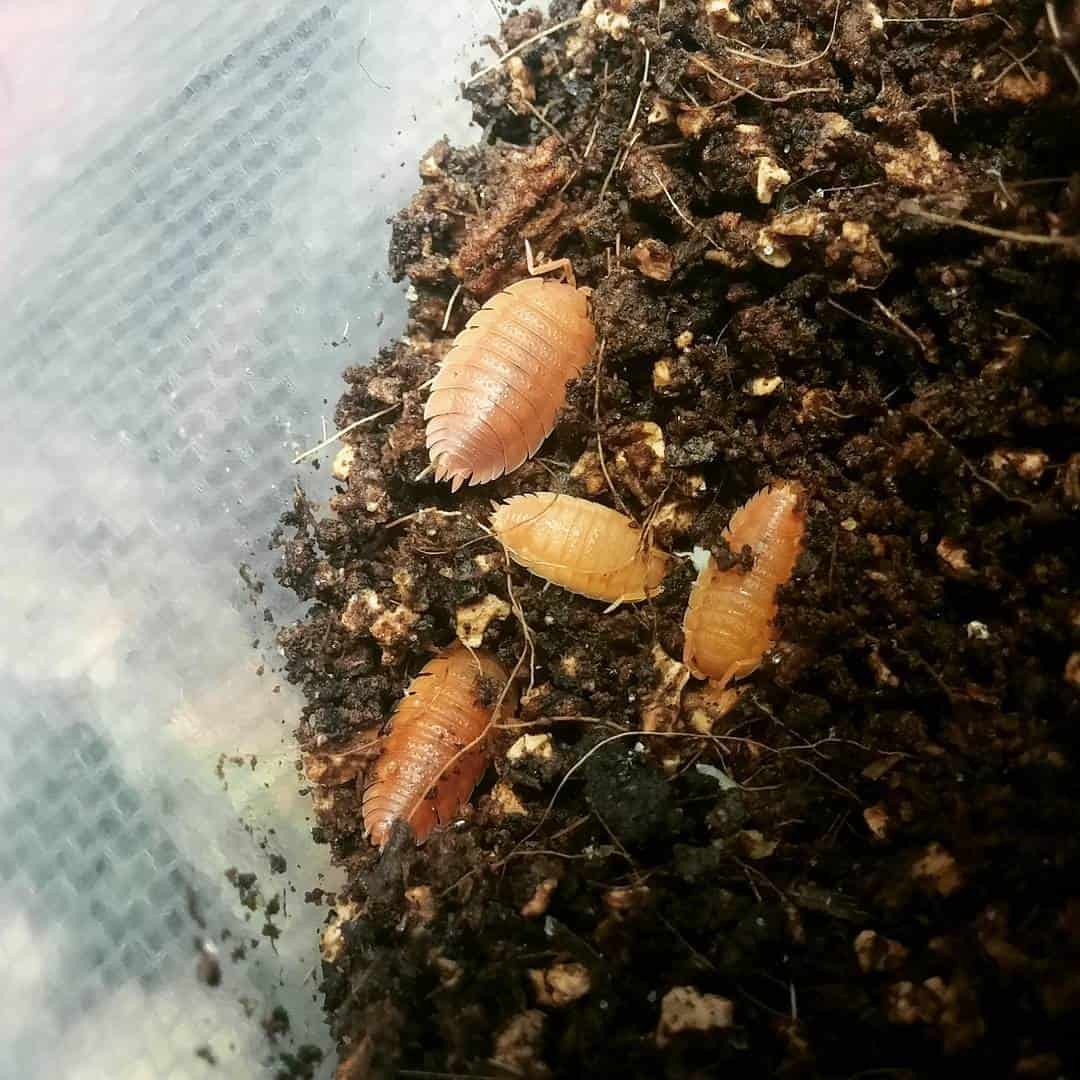
10. Terrarium Furniture
You can make this type of terrarium by making a small terrarium first and attaching it to the premade empty section of a table, chair, or wall.
But, if you are skilled in carpentry, you can also make furniture with compartments where you can add terrarium layers and elements and seal it from above using a clear glass pane.
Frequently Asked Questions about Terrariums
What Not to Put in Terrariums?
Plants with thinner leaves require more humidity, and terrariums are great places to receive moisture.
But, succulents have thicker leaves that can rot easily with high moisture. So in most cases, succulents have less chance of survival in terrariums.
How Long Does a Terrarium Last?
If a Closed terrarium keeps receiving the right balance of humidity, light, temperature, and soil, it can thrive indefinitely.
The longest self-sustaining terrarium is surviving since 1972.
How Often Should I Vent My terrarium?
You should vent a terrarium every 2-3 weeks for a few hours for air circulation inside it.
What Can I Put in Terrarium Other than Plants?
You can add figurines, rocks, colorful stones and sand, preserved flowers, and plastic toys.
However, these kinds of terrariums are better off without plants.
From Editorial Team
Protect terrariums from molds!
Molds can pose problems in closed terrariums.
So keep them in check by adding springtails, sterilizing the potting mix, removing the decaying leaves, avoiding overwatering, and offering air circulation.
